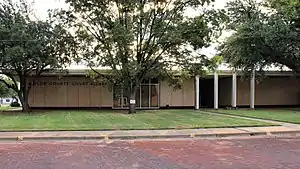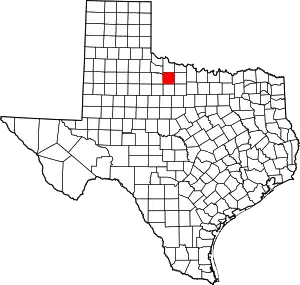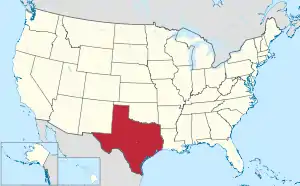Baylor County | |
|---|---|
 The Baylor County Courthouse in Seymour | |
 Location within the U.S. state of Texas | |
 Texas's location within the U.S. | |
| Coordinates: 33°38′N 99°13′W / 33.63°N 99.22°W | |
| Country | |
| State | |
| Founded | 1879 |
| Named for | Henry Weidner Baylor |
| Seat | Seymour |
| Largest city | Seymour |
| Area | |
| • Total | 901 sq mi (2,330 km2) |
| • Land | 867 sq mi (2,250 km2) |
| • Water | 34 sq mi (90 km2) 3.7% |
| Population (2020) | |
| • Total | 3,465 |
| • Density | 3.8/sq mi (1.5/km2) |
| Time zone | UTC−6 (Central) |
| • Summer (DST) | UTC−5 (CDT) |
| Congressional district | 13th |
| Website | www |
Baylor County is a county located in the U.S. state of Texas. As of the 2020 census, its population was 3,465.[1][2] Its county seat is Seymour.[3]
History
In 1858, the Texas Legislature established Baylor County, naming it for Henry Weidner Baylor, a surgeon in the Texas Rangers during the Mexican–American War. It organized in 1879.[4]
Geography
According to the U.S. Census Bureau, the county has a total area of 901 sq mi (2,330 km2), of which 34 sq mi (88 km2) (3.7%) are covered by water.[5]
Major highways
Adjacent counties
- Wilbarger County (north)
- Wichita County (northeast)
- Archer County (east)
- Young County (southeast)
- Throckmorton County (south)
- Haskell County (southwest)
- Knox County (west)
- Foard County (northwest)
Geology
Baylor County is part of the Texas Red Beds, which are strata of red-colored sedimentary rock from the Early Permian. The fossils of Permian period vertebrates in the Texas Red Beds were first discovered by Edward Drinker Cope in 1877.[6][7] Subsequent research has revealed rare fossils of Permian amphibians like Trimerorhachis,[8] as well as rich deposits of other Permian tetrapods such as Dimetrodon and Diadectes.[9] Seymouria baylorensis, a species of Seymouria, was first discovered and named after Baylor County and the city of Seymour.[10]
Demographics
| Census | Pop. | Note | %± |
|---|---|---|---|
| 1880 | 715 | — | |
| 1890 | 2,595 | 262.9% | |
| 1900 | 3,052 | 17.6% | |
| 1910 | 8,411 | 175.6% | |
| 1920 | 7,027 | −16.5% | |
| 1930 | 7,418 | 5.6% | |
| 1940 | 7,755 | 4.5% | |
| 1950 | 6,875 | −11.3% | |
| 1960 | 5,893 | −14.3% | |
| 1970 | 5,221 | −11.4% | |
| 1980 | 4,919 | −5.8% | |
| 1990 | 4,385 | −10.9% | |
| 2000 | 4,093 | −6.7% | |
| 2010 | 3,726 | −9.0% | |
| 2020 | 3,465 | −7.0% | |
| U.S. Decennial Census[11] 1850–2010[12] 2010[13] 2020[14] | |||
| Race / Ethnicity | Pop 2010[13] | Pop 2020[14] | % 2010 | % 2020 |
|---|---|---|---|---|
| White alone (NH) | 3,147 | 2,797 | 84.46% | 80.72% |
| Black or African American alone (NH) | 71 | 52 | 1.91% | 1.50% |
| Native American or Alaska Native alone (NH) | 10 | 11 | 0.27% | 0.32% |
| Asian alone (NH) | 4 | 9 | 0.11% | 0.26% |
| Pacific Islander alone (NH) | 3 | 0 | 0.08% | 0.00% |
| Some Other Race alone (NH) | 1 | 8 | 0.03% | 0.23% |
| Mixed Race/Multi-Racial (NH) | 35 | 149 | 0.94% | 4.30% |
| Hispanic or Latino (any race) | 455 | 439 | 12.21% | 12.67% |
| Total | 3,726 | 3,465 | 100.00% | 100.00% |
Note: the US Census treats Hispanic/Latino as an ethnic category. This table excludes Latinos from the racial categories and assigns them to a separate category. Hispanics/Latinos can be of any race.
As of the census[15] of 2000, 4,093 people, 1,791 households, and 1,156 families resided in the county. The population density was five people per square mile (1.9 people/km2). The 2,820 housing units averaged three units per square mile (1.2 units/km2). The racial makeup of the county was 90.96% White, 3.35% Black or African American, 0.59% Native American, 0.51% Asian, 0.12% Pacific Islander, 3.32% from other races and 1.15% from two or more races; 9.33% were Hispanic or Latino of any race.
Of the 1,791 households, 25.2% had children under the age of 18 residing in them, 53.5% were married couples living together, 8.2% had a female householder with no husband present, and 35.4% were not families. In addition, 33.30% of all households were made up of individuals, and 19.2% had someone living alone who was 65 years of age or older. The average household size was 2.26 and the average family size was 2.86.
In the county, the population was distributed as 23.4% under the age of 18, 5.5% from 18 to 24, 21.4% from 25 to 44, 25.6% from 45 to 64, and 24.1% who were 65 years of age or older. The median age was 45 years. For every 100 females, there were 89.50 males. For every 100 females age 18 and over, there were 86.70 males.
The median income for a household in the county was $24,627, and for a family was $34,583. Males had a median income of $21,607 versus $19,571 for females. The per capita income for the county was $16,384. About 16.1% of the population and 12.9% of families were below the poverty line, and 26.3% of those under the age of 18 and 9% of those 65 and older were living below the poverty line.
Educational attainment
According to the 2000 census, 21.2% of those aged over 25 did not have a high school diploma, while 32.7% did. Roughly 8.7% of the population had a bachelor's degree, 2.3% had a master's degree, and 0.2% had a doctoral degree. No males had doctoral degrees, while 0.4% of females had one.
Education
Almost all of Baylor County is served by the Seymour Independent School District, which also serves portions of adjacent counties. A small portion is served by the Olney Independent School District.[16] The OISD portion was served by the Megargel Independent School District,[17] until MISD closed after May 2006.[18]
The county is in the service area of Vernon College.[19]
Communities
City
Unincorporated communities
Politics
Baylor County is represented in the Texas House of Representatives by Republican James Frank, a businessman from Wichita Falls.
| Year | Republican | Democratic | Third party | |||
|---|---|---|---|---|---|---|
| No. | % | No. | % | No. | % | |
| 2020 | 1,494 | 87.78% | 183 | 10.75% | 25 | 1.47% |
| 2016 | 1,267 | 84.52% | 191 | 12.74% | 41 | 2.74% |
| 2012 | 1,297 | 81.47% | 267 | 16.77% | 28 | 1.76% |
| 2008 | 1,262 | 76.81% | 366 | 22.28% | 15 | 0.91% |
| 2004 | 1,169 | 71.28% | 467 | 28.48% | 4 | 0.24% |
| 2000 | 1,285 | 64.77% | 663 | 33.42% | 36 | 1.81% |
| 1996 | 860 | 41.23% | 955 | 45.78% | 271 | 12.99% |
| 1992 | 611 | 28.66% | 990 | 46.44% | 531 | 24.91% |
| 1988 | 914 | 44.15% | 1,153 | 55.70% | 3 | 0.14% |
| 1984 | 1,314 | 56.01% | 1,019 | 43.44% | 13 | 0.55% |
| 1980 | 1,098 | 47.61% | 1,183 | 51.30% | 25 | 1.08% |
| 1976 | 783 | 36.76% | 1,335 | 62.68% | 12 | 0.56% |
| 1972 | 1,190 | 66.52% | 598 | 33.43% | 1 | 0.06% |
| 1968 | 657 | 30.36% | 1,064 | 49.17% | 443 | 20.47% |
| 1964 | 389 | 21.68% | 1,403 | 78.21% | 2 | 0.11% |
| 1960 | 713 | 37.27% | 1,199 | 62.68% | 1 | 0.05% |
| 1956 | 715 | 40.49% | 1,047 | 59.29% | 4 | 0.23% |
| 1952 | 879 | 43.43% | 1,142 | 56.42% | 3 | 0.15% |
| 1948 | 101 | 6.03% | 1,522 | 90.81% | 53 | 3.16% |
| 1944 | 102 | 5.70% | 1,568 | 87.65% | 119 | 6.65% |
| 1940 | 139 | 7.69% | 1,667 | 92.25% | 1 | 0.06% |
| 1936 | 100 | 6.09% | 1,541 | 93.85% | 1 | 0.06% |
| 1932 | 55 | 3.68% | 1,437 | 96.25% | 1 | 0.07% |
| 1928 | 491 | 38.51% | 784 | 61.49% | 0 | 0.00% |
| 1924 | 135 | 11.61% | 1,012 | 87.02% | 16 | 1.38% |
| 1920 | 139 | 16.18% | 632 | 73.57% | 88 | 10.24% |
| 1916 | 47 | 5.62% | 711 | 85.05% | 78 | 9.33% |
| 1912 | 15 | 2.43% | 551 | 89.30% | 51 | 8.27% |
See also
References
- ↑ "U.S. Census Bureau QuickFacts: Baylor County, Texas". United States Census Bureau. Retrieved January 31, 2022.
- ↑ "Baylor County, Texas". United States Census Bureau. Retrieved February 23, 2021.
- ↑ "Find a County". National Association of Counties. Archived from the original on July 4, 2012. Retrieved 2011-06-07.
- ↑ "Texas: Individual County Chronologies". Texas Atlas of Historical County Boundaries. The Newberry Library. 2008. Archived from the original on April 12, 2017. Retrieved May 20, 2015.
- ↑ "2010 Census Gazetteer Files". United States Census Bureau. August 22, 2012. Retrieved April 19, 2015.
- ↑ Cope, E. D. Descriptions of extinct vertebrata from the Permian and Triassic formations of the United States. Proceedings of the American Philosophical Society, 1877. Volume 17:182–195. JSTOR. Accessed on August 28, 2017.
- ↑ Case, E.C. The Red Beds between Wichita Falls, Texas, and Las Vegas, New Mexico, in Relation to Their Vertebrate Fauna. The Journal of Geology, vol. 22, no. 3, 1914, pp. 243–259. JSTOR. Accessed on August 28, 2017.
- ↑ Henry, Randy. NRCS and Landowner Team Up With Houston Museum after Rare Species Discovery. Natural Resources Conservation Service. Accessed on August 28, 2017.
- ↑ Caulfield, Dave. Prehistoric Predators: Fossil Findings in Seymour 'Redefining'. Newschannel 6: October 25, 2015. Accessed on August 28, 2017.
- ↑ Williston, S. W. Restoration of Seymouria Baylorensis Broili, an American Cotylosaur. The Journal of Geology: 1911, vol. 19, no. 3, pp. 232–237. JSTOR. Accessed on August 28, 2017.
- ↑ "Decennial Census of Population and Housing by Decades". US Census Bureau.
- ↑ "Texas Almanac: Population History of Counties from 1850–2010" (PDF). Texas Almanac. Archived (PDF) from the original on October 9, 2022. Retrieved April 19, 2015.
- 1 2 "P2 HISPANIC OR LATINO, AND NOT HISPANIC OR LATINO BY RACE - 2010: DEC Redistricting Data (PL 94-171) - Baylor County, Texas". United States Census Bureau.
- 1 2 "P2 HISPANIC OR LATINO, AND NOT HISPANIC OR LATINO BY RACE - 2020: DEC Redistricting Data (PL 94-171) - Baylor County, Texas". United States Census Bureau.
- ↑ "U.S. Census website". United States Census Bureau. Retrieved 2011-05-14.
- ↑ "2020 CENSUS - SCHOOL DISTRICT REFERENCE MAP: Baylor County, TX" (PDF). U.S. Census Bureau. Archived (PDF) from the original on October 9, 2022. Retrieved June 29, 2022. - Text list
- ↑ Texas Education Agency: See map of Baylor County. Retrieved on April 9, 2020.
- ↑ "Mergargel School Closes Its Doors". KAUZ-TV. Archived from the original on September 28, 2007. Retrieved July 17, 2010.
- ↑ Texas Education Code, Sec. 130.207. VERNON REGIONAL JUNIOR COLLEGE DISTRICT SERVICE AREA.
- ↑ Leip, David. "Dave Leip's Atlas of U.S. Presidential Elections". uselectionatlas.org. Retrieved July 19, 2018.
External links
- Baylor County from the Handbook of Texas Online
- Baylor County from the Texas Almanac
- Baylor County from the TXGenWeb Project
- Baylor County Profile from the Texas Association of Counties
- Baylor County Website